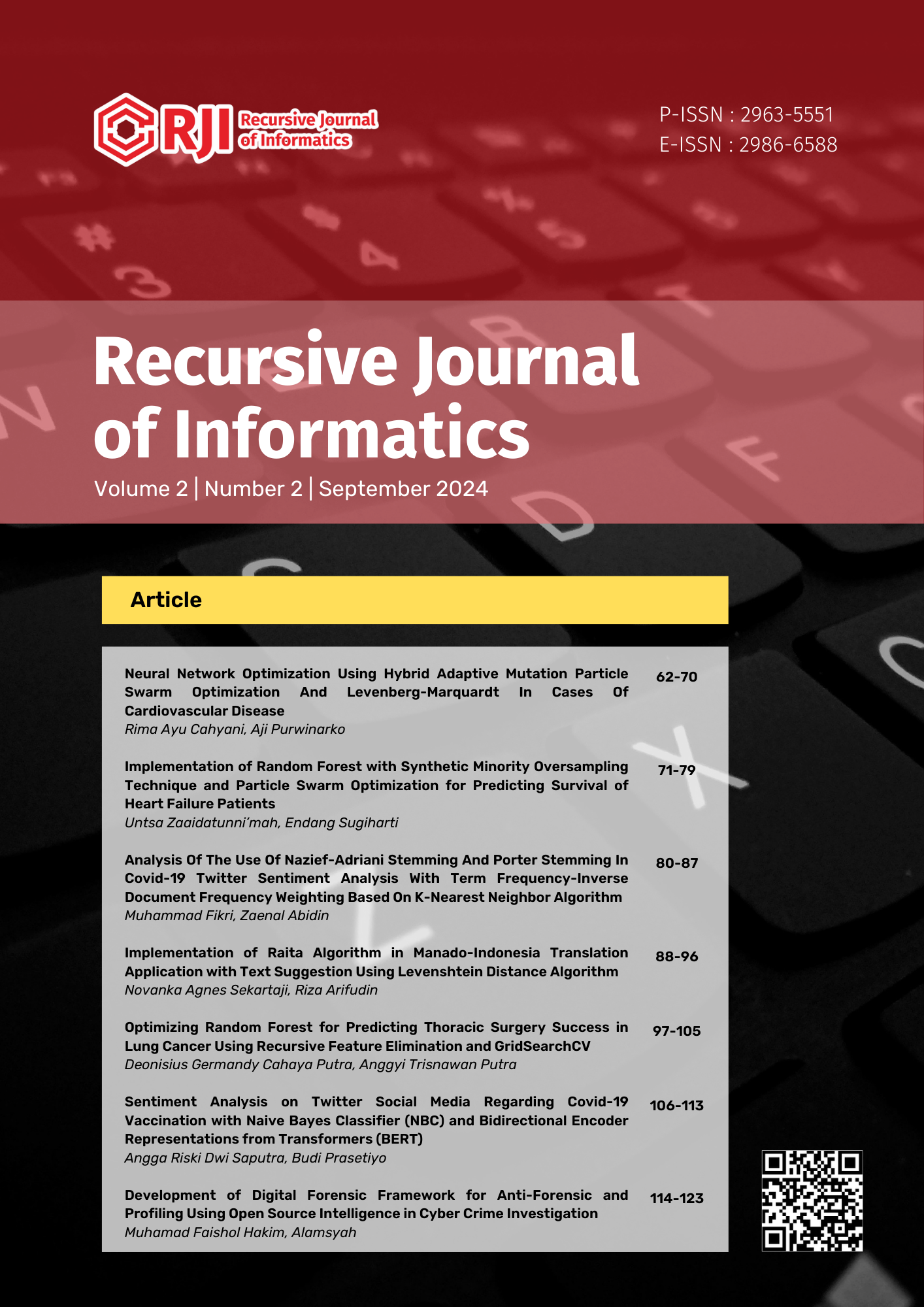Neural Network Optimization Using Hybrid Adaptive Mutation Particle Swarm Optimization and Levenberg-Marquardt in Cases of Cardiovascular Disease
Abstract
Abstract. Cardiovascular disease is a condition generally characterized by the narrowing or blockage of blood vessels, which can lead to heart attacks, chest pain, or strokes. It is the leading cause of death worldwide, accounting for approximately 31% or 17.9 million deaths each year globally. Deaths caused by cardiovascular disease are projected to continue increasing until 2030, with the number of patients reaching 23.3 million. As cases of death due to cardiovascular disease become more prevalent, early detection is crucial to reduce mortality rates.
Purpose: Many previous researchers have conducted studies on predicting cardiovascular disease using neural network methods. This study extends these methods by incorporating feature selection and optimization with Hybrid AMPSO-LMA. The research is designed to explore the implementation and predictive outcomes of Hybrid AMPSO-LMA in optimizing MLP for cases of cardiovascular disease.
Methods/Study design/approach: The first step in conducting this research is to download the Heart Disease Dataset from Kaggle.com. The dataset is processed through preprocessing by removing duplicates and transforming the data. Then, data mining processes are carried out using the MLP algorithm optimized with Hybrid AMPSO-LMA to obtain results and conclusions. This system is designed using the Python programming language and utilizes Flask for website access in HTML.
Result/Findings: The research results demonstrate that the method employed by the author successfully improves the accuracy of predicting cardiovascular disease. Predicting cardiovascular disease using the MLP algorithm yields an accuracy of 86.1%, and after optimization with Hybrid AMPSO-LMA, the accuracy increases to 86.88%.
Novelty/Originality/Value: This effort will contribute to the development of a more reliable and effective cardiovascular disease prediction system, with the goal of early identification of individuals exhibiting symptoms of cardiovascular disease.
References
[2] S. S. Virani et al., Heart disease and stroke statistics—2020 update a report from the American Heart Association, vol. 141, no. 9. 2020. doi: 10.1161/CIR.0000000000000757.
[3] W. Nugraha, “Prediksi penyakit jantung cardiovascular menggunakan model algoritma klasifikasi,” J. Manag. dan Inform., vol. 9, no. 2, pp. 3–8, 2021.
[4] J. W. G. Putra, Pengenalan Konsep Pembelajaran Mesin dan Deep Learning, 1.4. Tokyo: wiragotama.github.io, 2020. [Online]. Available: https://www.researchgate.net/publication/323700644_Pengenalan_Pembelajaran_Mesin_dan_Deep_Learning
[5] A. S. Diantika and Y. Firmanto, “Implementasi machine learning pada aplikasi penjualan produk digital (studi pada GrabKios),” J. Ilm. Mhs. FEB, vol. 53, no. 9, pp. 1689–1699, 2019.
[6] E. Retnoningsih and R. Pramudita, “Mengenal machine learning dengan teknik supervised dan unsupervised learning menggunakan Python,” Bina Insa. Ict J., vol. 7, no. 2, pp. 156–165, 2020, doi: 10.51211/biict.v7i2.1422.
[7] A. F. Achmalia, Walid, and Sugiman, “Peramalan penjualan semen menggunakan backpropagation neural network dan recurrent neural network,” UNNES J. Math., vol. 8, no. 1, pp. 92–106, 2019, doi: 10.15294/UJM.V9I1.29970.
[8] H. M. Nawawi, J. J. Purnama, and A. B. Hikmah, “Komparasi algoritma neural network dan naïve Bayes untuk memprediksi penyakit jantung,” J. Pilar Nusa Mandiri, vol. 15, no. 2, pp. 189–194, 2019, doi: 10.33480/pilar.v15i2.669.
[9] F. Handayani, “Komparasi support vector machine, logistic regression dan artificial neural network dalam prediksi penyakit jantung,” J. Edukasi dan Penelit. Inform., vol. 7, no. 3, p. 329, 2021, doi: 10.26418/jp.v7i3.48053.
[10] A. Kurniawan and A. Silvanie, “Prediksi penyakit jantung menggunakan jaringan syaraf tiruan multi layer perceptron dan Python pada basis data penyakit jantung di Ceveland,” JUNIF J. Nas. Inform., vol. 2, no. 1, pp. 21–28, 2021.
[11] A. N. Sari and S. Alfionita, “Klasifikasi penyakit jantung menggunakan metode naïve Bayes,” AMRI (Analisa Metod. Rekayasa Inform., vol. 1, no. 1, pp. 22–26, 2022, doi: 10.12487/AMRI.v1i1.xxxxx.
[12] F. N. S. Inggih Permana, “The Effect of Data Normalization on the Performance of the Classification Results of the Backpropagation Algorithm,” IJIRSE Indones. J. Inform. Res. Softw. Eng., vol. 2, no. 1, pp. 67–72, 2022.
[13] Gde Agung Brahmana Suryanegara, Adiwijaya, and Mahendra Dwifebri Purbolaksono, “Peningkatan Hasil Klasifikasi pada Algoritma Random Forest untuk Deteksi Pasien Penderita Diabetes Menggunakan Metode Normalisasi,” J. RESTI (Rekayasa Sist. dan Teknol. Informasi), vol. 5, no. 1, pp. 114–122, 2021, doi: 10.29207/resti.v5i1.2880.
[14] Ainurrochman, D. P. Adi, and A. B. Gumelar, “Deteksi Emosi Wicara pada Media On-Demand menggunakan SVM dan LSTM,” J. RESTI (Rekayasa Sist. dan Teknol. Informasi), vol. 4, no. 5, pp. 799–804, 2020, doi: 10.29207/resti.v4i5.2073.
[15] D. ARIYOGA, “Perbandingan Metode Seleksi Fitur Filter, Wrapper, Dan Embedded Pada Klasifikasi Data Nirs Mangga Menggunakan Random Forest Dan Support Vector Machine …,” 2022, [Online]. Available: https://dspace.uii.ac.id/handle/123456789/38955
[16] Generosa Lukhayu Pritalia, “Analisis Komparatif Algoritme Machine Learning dan Penanganan Imbalanced Data pada Klasifikasi Kualitas Air Layak Minum,” KONSTELASI Konvergensi Teknol. dan Sist. Inf., vol. 2, no. 1, pp. 43–55, 2022, doi: 10.24002/konstelasi.v2i1.5630.
[17] E. Subiyantoro and Azhari, “Autonomous Cognitive Leveling Game Pada Serious Game Menggunakan Particle Swarm Optimization,” J. Buana Inform., vol. 8, no. 2, pp. 87–98, 2017.
[18] V. Julianto, H. S. Utomo, and M. R. Arrahimi, “Penerapan bat algorithm dalam penyelsaian kasus travelling salesman problem (TSP) pada internship program,” J. Ilm. Inform., vol. 6, no. 2, pp. 111–116, 2021, doi: 10.35316/jimi.v6i2.1485.
[19] J. Bilski, B. Kowalczyk, A. Marchlewska, and J. M. Zurada, “Local Levenberg-Marquardt algorithm for learning feedforwad neural networks,” J. Artif. Intell. Soft Comput. Res., vol. 10, no. 4, pp. 299–316, 2020, doi: 10.2478/jaiscr-2020-0020.









